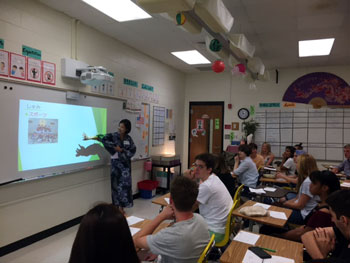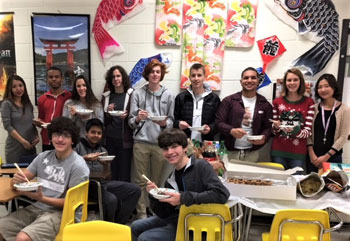

 2017 J-LEAP Report
2017 J-LEAP ReportRoswell High School
Roswell, GA
Konnichiwa! My name is Mika Muchima. I’m from Kumamoto, and I have been teaching at Roswell High School as an assistant teacher. Since I was an elementary school student, I have had a lot of opportunities to communicate with people from foreign countries. I also like watching movies, especially ones made in America. Because of those reasons, working in America someday had been my dream and now my dream has come true at Roswell High School!
Georgia
When I heard that I was going to Georgia for the first time, I had no idea where Georgia was. I knew the name of it from the brand of coffee though! Georgia is in the southeastern part of America and is known as the Peach State and the Empire State of the South. It has the largest airport and aquarium in America. The headquarters of CNN, Coca Cola and Aflac are located in Atlanta, which is the state’s capital, and its most populous city. There are more than five hundred companies which are related to Japan in Georgia. Japanese culture, especially Japanese foods are getting more popular, and I can find so many Japanese restaurants and food at grocery stores. I can’t believe that five months have already passed in Georgia. I really like it here because it is similar to Kumamoto in nature, climate and how people are nice to me!
 Japanese classes at Roswell High School
Japanese classes at Roswell High School
Roswell High School is a public school that was established in 1949. But the current facility opened in 1990. The number of the students is about 2200. The school is comprised of students from all over the world, and this rarely happens in Japanese schools. There are world language classes that are Japanese, French, Latin, German and Italian and often students take one of them. In Japanese class, there are 7 levels: 5H, 4H, 3H, 3, 2H, 2 and 1. Among those 7 levels, I teach 5 classes. There are 31 students in the largest class. The reason the students take Japanese is because they like Japanese culture especially Manga, Anime and Japanese foods. Some students have studied Japanese since they were in middle school and that is also one of the reason they learn Japanese at high school. We use textbooks named Adventure in Japanese and at the end of each unit, we often do skit projects where students show their Japanese skills they learned in the unit. I think they have more opportunities to do speaking activities compared to when I was studying English in Japan.
Each unit in the text book has a section about Japanese culture. I do some presentations about Japanese culture along with the topic so that the students can learn more about Japanese culture from what I experienced in Japan. I use Japanese that students learned in the unit. When I spoke about school uniforms and rules, I showed some pictures of my high school’s uniform and classroom. I also have a conversation time called Muchima sensei to Oshaberi for the first ten minutes just after the class starts. I choose two students randomly each day and they each have one on one conversation time with me only in Japanese. We don’t grade it. It is just for fun and gives them the opportunity to speak in Japanese with a native speaker. Onuki sensei, my lead teacher, suggested this activity to me so that I can get to know more about the students.
Outside of school
I had an opportunity to teach Japanese at the Ron Clark Academy, which is a private school, for four days in October. There were twenty-eight students, and I taught them basic Japanese phrases and shared Japanese culture with them so that students could be ready for a trip to Japan. It was a big challenge for me to teach by myself, without my LT. But it was a really good opportunity to learn how to do a lesson and control students by myself. I also learned how important it is to prepare for lessons beforehand. I also go to a middle school once a month to help a Japanese club. When we had the club in September, we had Otsukimi-dango (Japanese sweet dumpling ball). In October, we made Onigiri (rice ball) shaped like mummies, Frankensteins and Jack-O’-Lanterns. I am glad to communicate with not only with high school students but also middle school students here.
My lead teacher, Onuki-sensei, also participated in the J-LEAP program during the first year. She was also given the opportunity to teach as an assistant teacher in Georgia. She always helps me and provides feedback on how I can improve myself as an AT in a class. One of my goals is for students to have more fun learning Japanese with me in a class. I will do my best to achieve my goal! Thank you for reading!!